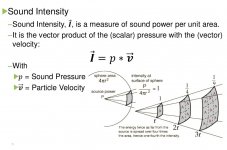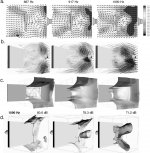So, we're looking at Ia then; particle velocity in the absence of a pressure component (pv)?
It seems the results in #2756-2758 are in accordance with research by others in this field.
It seems the results in #2756-2758 are in accordance with research by others in this field.
Last edited:
We are looking at Intensity (power / unit area) which is the product of the Velocity vector and the pressure. Just like electrical power is the product of current times voltage.
Mabat, Normalizing may be very misleading, I'd try log. Or just show a few planes closer to the mouth unnormalized.
Mabat, Normalizing may be very misleading, I'd try log. Or just show a few planes closer to the mouth unnormalized.
"Practical method for evaluating the sound field radiated from a waveguide" (Feng, 2015), in reference to the work of Dr. Geddes a.o.
and another Chinese, very recent paper:
"Shape Optimization of an Acoustic Horn by using the Multi-Modal Method" (Dong, 2020).
There is one 'drawback'; both papers assume a horn in a baffle.
and another Chinese, very recent paper:
"Shape Optimization of an Acoustic Horn by using the Multi-Modal Method" (Dong, 2020).
There is one 'drawback'; both papers assume a horn in a baffle.
Attachments
Last edited:
We are looking at Intensity (power / unit area) which is the product of the Velocity vector and the pressure. Just like electrical power is the product of current times voltage.
For those without a background in Acoustics:
Attachments
Well it is a little more complicated, as the intensity is a complex quantity, at least in this case, as is the pressure. It's still not clear to me how to visualize that. All the above graphs display the real part (in the x and y directions, forming a vector). Is that what we should look at? I'm really not sure about the physical interpretation.
(PDF) Measurement of complex acoustic intensity in an acoustic waveguide
- Finally I have the OS coordinates (it took me a while to realize the relation between the throat radius and the foci distance). I can now draw them as a background grid and/or display the two vectors as mentioned before. But I guess I should take a damping-terminated waveguide to remove the mouth related issues, is that right?
(PDF) Measurement of complex acoustic intensity in an acoustic waveguide
- Finally I have the OS coordinates (it took me a while to realize the relation between the throat radius and the foci distance). I can now draw them as a background grid and/or display the two vectors as mentioned before. But I guess I should take a damping-terminated waveguide to remove the mouth related issues, is that right?
Last edited:
It seems they consider it only real in that paper, i.e. not taking phases of the pressures into account at all.
Well it is a little more complicated, as the intensity is a complex quantity, at least in this case, as is the pressure.
The intensity is not complex - remember that the definition uses the complex conjugate which results in a purely real number despite the two vales being complex. Think of it as a magnitude calculation.
All work/power relationships have to be real.
A product of two complex numbers, whatever they are, is never guaranteed to result in a real number (the sum of their arguments would have to be an exact integer multiple of pi, which will hardly ever happen). It is only guaranteed if you add a complex number to its conjugate but that's nowhere used here. Actually the calculation of sound intensity from complex pressure field leads naturally to complex quantity. In the above paper they tried to even measure complex sound intensity. So obviously there is something as a complex sound intensity, and the fact is that I'm not sure how to use it properly.
I could make it purely real by using only the magnitudes of the averages and differences of the pressures that are used in the calculation. I may try that. I'm only not sure it would tell the whole story.
A quote from that paper:
"[...] However, when the particle velocity and pressure are not in phase, additional information may be obtained by accounting for this phase difference, and this can be realized by treating intensity as a complex quantity where the real part represents the magnitude of the local mean energy flow and the imaginary part the local oscillatory transport of energy. Accordingly, complex intensity will deliver additional information regarding energy transport but only in regions of sound scattering and/or when higher order modes are propagating in a waveguide."
I could make it purely real by using only the magnitudes of the averages and differences of the pressures that are used in the calculation. I may try that. I'm only not sure it would tell the whole story.
A quote from that paper:
"[...] However, when the particle velocity and pressure are not in phase, additional information may be obtained by accounting for this phase difference, and this can be realized by treating intensity as a complex quantity where the real part represents the magnitude of the local mean energy flow and the imaginary part the local oscillatory transport of energy. Accordingly, complex intensity will deliver additional information regarding energy transport but only in regions of sound scattering and/or when higher order modes are propagating in a waveguide."
Last edited:
Or if you multiply it by its conjugate, of course, but again, this is not the case here as the intensity is the product of pressure and velocity, i.e. different quantities. It doesn't matter if you take a conjugate of one of them. That won't make it real number.... It is only guaranteed if you add a complex number to its conjugate but that's nowhere used here.
Yes, I got that one wrong! My bad! I remember now that a colleague in school studied reactive intensity and concluded just what was stated above. But that was 40 years ago and in that time not much interest has evolved in reactive intensity. It does not propagate and hence is not really relevant to anything away from a source.
However in "Acoustics", Pierce defines the intensity as the real part of the product of v and conjugate p (EQ. 1-11.11b,) so by this definition the intensity is always real. That a Reactive intensity can be defined means that it is really a different thing than "Intensity" as thought of in the field.
However in "Acoustics", Pierce defines the intensity as the real part of the product of v and conjugate p (EQ. 1-11.11b,) so by this definition the intensity is always real. That a Reactive intensity can be defined means that it is really a different thing than "Intensity" as thought of in the field.
Last edited:
Some authors use Re{p* v}, some use Re{p v*} (as the preferred form) - the reasons for this are far beyond my knowledge of the matter - I saw an explanation somewhere but forgot it already.
Slightly off-topic - I've just ordered new Faitals HF1440 for €225/piece. Hope they are worth it! 🙂
Last edited:
Cool on the paper, just need to EQ all what is above 109 dB...
But I'm asking myself what horn was used for such a good result on the dartasheet ?!
But I'm asking myself what horn was used for such a good result on the dartasheet ?!
... so a Tractrix. Did you have already sketched an horn for it ?🙂
They say 700 hz but watching the impedance curve, 700 hz is 40 ohms... are they not a little bit optimist and should have said 900/1000 hz cut-off for this driver😕
Anyway with the keton polymer and such good curve since EQ, I'm sure most of people could be surely happy with such a compression driver... price is good , though more expensive inside EC.
They say 700 hz but watching the impedance curve, 700 hz is 40 ohms... are they not a little bit optimist and should have said 900/1000 hz cut-off for this driver😕
Anyway with the keton polymer and such good curve since EQ, I'm sure most of people could be surely happy with such a compression driver... price is good , though more expensive inside EC.
I don't have a clue how they come to those numbers.
I would like to measure the exit wavefront so the PWT may well be the next project to finish...
I would like to measure the exit wavefront so the PWT may well be the next project to finish...
hey, hey...😀
It's above my head, I assume it's safe from X-mech at 700 hz XO, while they don't say about the crossover order applied... As basic understnder, for me it's a 1000 hz cut-off usuable driver, while if the amp/driver combo can manage it at 700 hz/40 ohms in an active setup for a different amp for the lower driver, then perhaps I dunno... find the curve almost too clean while the first impedance raise seems too large for a 700 hz despite the strong motor 😕 I don't kno how to read this dataheet while not having the knowledge for it really 🙁 . You tell us after firt listenings 🙂
Edit : I could live with something like that but flat 109 db so without the bump above the 110 db line and the natural roll off after.
here the pink noise of a classic 3 ways mine that sounds good to me and music pro buddies (acoustical instruments players)
It's above my head, I assume it's safe from X-mech at 700 hz XO, while they don't say about the crossover order applied... As basic understnder, for me it's a 1000 hz cut-off usuable driver, while if the amp/driver combo can manage it at 700 hz/40 ohms in an active setup for a different amp for the lower driver, then perhaps I dunno... find the curve almost too clean while the first impedance raise seems too large for a 700 hz despite the strong motor 😕 I don't kno how to read this dataheet while not having the knowledge for it really 🙁 . You tell us after firt listenings 🙂
Edit : I could live with something like that but flat 109 db so without the bump above the 110 db line and the natural roll off after.
here the pink noise of a classic 3 ways mine that sounds good to me and music pro buddies (acoustical instruments players)
Attachments
Last edited:
Well 1 kHz would be quite an understatement, IMHO. I'd definitely aim for more something like 700 Hz, maybe even lower. I'm not afraid of impedances 🙂
EQ is a necessity for almost all driver/waveguide combinations. But that is harmless.
EQ is a necessity for almost all driver/waveguide combinations. But that is harmless.
I agree! For home Hi-Fi. Sound reinforcement is another thing. That's where a lot of these misconceptions arise.
- Home
- Loudspeakers
- Multi-Way
- Acoustic Horn Design – The Easy Way (Ath4)


